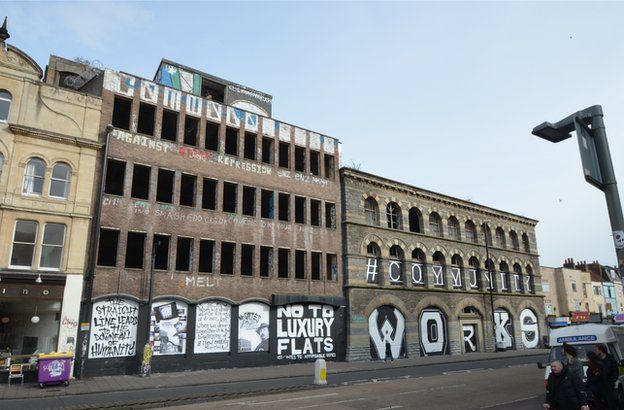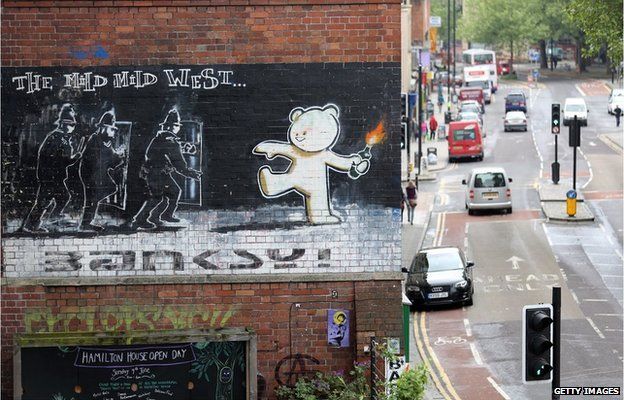Bristol's Stokes Croft: Battle over 'home' of Banksy
- 8 April 2015
- Bristol

A derelict listed building at risk of being lost could finally be redeveloped, but hundreds of people have objected to the plans that will be debated later.
Developing the Carriageworks would provide much-needed housing in Bristol and rid the Stokes Croft community of an "eyesore". But, would it destroy the soul of an area famed for street art by the likes of Banksy?
"He's arguably the most significant artist ever to come out of Bristol," says Chris Chalkley, chairman of community group the Peoples Republic of Stokes Croft (PRSC).
"That building, which was the first carriage showroom anywhere, deserves better than to be turned into luxury flats."
Mr Chalkley is not talking about artist Banksy, who painted his famed mural The Mild Mild West further along Stokes Croft.
He is talking about architect EW Godwin, who built the Grade II* listed Carriageworks in 1862, for horse carriage manufacturers John Perry and Sons.

The building was later used as offices for Regional Pools Promotions, and in the 1960s the organisation added the concrete building Westmoreland House next door.
But, both buildings have been empty for three decades, and their deterioration largely contributed to English Heritage classifying the entire Stokes Croft Conservation Area as "at risk".
Now, a planning application for Westmoreland House to be demolished and for the Carriageworks to be turned into 118 flats has been recommended for approval at a Bristol City Council meeting later.
So why is there wide opposition?
Fifteen influential people - including the executive chairman of Aardman Animations, and the council's former head of planning services - have signed an open letter calling for the proposals to be rejected.
The report for the council's planning committee also acknowledges 1361 objections from the public, while there have been just 21 responses in support.
Many people, including the PRSC, fear the gentrification of the area.
"If this development goes ahead it will irrevocably change the nature of the area," said Mr Chalkley.
"Stokes Croft is an area that's always had an independent spirit. It's an area that's become a beacon of alternative thinking."
He remembers Stokes Croft being "shunned" through decades of neglect by people in power, but says the community turned the area around for itself.
People now come from all over the world to see the street art and experience being in an "outdoor gallery", he says.
"We now find ourselves where after 30 years of dereliction, and the community having developed within that, all of that can be swept away because some developers from elsewhere deem that might be a good thing," says Mr Chalkley.
"In 2011, this community had Tesco forced upon it and we saw what happened."
Opposition to Tesco led to two nights of violent clashes between protesters and police.
A protest march is also planned against the Carriageworks development, to coincide with the council meeting.
English Heritage, which has since been succeeded by Historic England, has backed the council in support of the application.
The site has been on the Heritage At Risk Register since 1998, and is one of Historic England's risk priority sites in the South West.
In his letter to the council Simon Ramsden, principal inspector of historic buildings and areas, said he hoped the proposals "can be delivered in the near future in order to prevent any further damage" to the important building.
The Carriageworks Action Group (CAG), an alliance of residents and businesses, agrees the building needs developing, but says the proposals are not good enough.
"What's proposed is bland, boring and a pastiche, what you would find in any boring high street in any clone town in the country," says Lori Streich, who chairs the group.
The group wants an "innovative and interesting design" that befits the "iconic and fantastic" design of the Carriageworks.
CAG, supported by the council, had been working on its own proposals with a housing association called Knightstone, but these were put on hold following the planning application by Fifth Capital London.
The community had wanted a mix of affordable housing and units for small businesses.
"What we want and what the community desperately needs is affordable housing, and the Fifth Capital proposals are for only eight out of 118 to be affordable," says Ms Streich.
The city's mayor, George Ferguson, says the council remains "committed to the regeneration of this eyesore site", and will continue to consider options for a compulsory purchase order should the owner either fail to secure planning consent or to develop the site.
Bristol Civic Society supported the work of CAG and Knightstone, but also supports the current planning application.
It has wanted the Carriageworks to be developed for years, although it has opposed all previous planning applications.
"The current application is a pretty attractive one," says chairman Simon Birch.
"The quality of the architecture is good and if it gets built in the way that is proposed it will look fantastic."
He believes the 1960s building is "a horror" and welcomes its demolition.
Fifth Capital London director Marc Pennick sounds surprised by the opposition he has encountered in Bristol.
"People say they want investment but it seems that certain factions of the area don't want change," he says.
Fifth Capital London does not own the property, but Mr Pennick says he has agreed to buy it from Comer Homes if planning permission is given.
He likes the Carriageworks because it is a listed building, and he sees it as "a great opportunity to put something back into the area".
Mr Pennick estimates between £15m and £20m is needed to develop it, and the only way to raise this "serious amount of money" is by building and selling flats.
The decision is now in the hands of councillors, but Mr Pennick says he will "find a way forward" even if they refuse permission.
"I've started this," he says. "I'm not going to stop."
--
My pictures from Stokes Croft, taken in February 2015:
Banksy's famous "Mild Mild West" at the Hamilton House on Stokes Croft:
More of Stokes Croft and nearby streets:
--












No comments:
Post a Comment